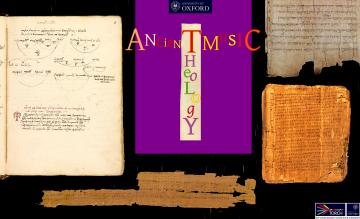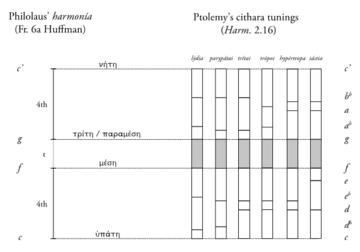Ancient Music and Theology: Opening a dialogue
Ancient Music and Theology: Opening a dialogue
The last decades have seen an unprecedented growth in our knowledge of ancient Greek and Roman Mousikē, covering both cultural and technical questions. This vital evidence now allows us to recapture the defining features of ancient scales, rhythms and instruments, and their developments in Classical, Hellenistic and late antique times. It also sheds new light on influential accounts of the ethical, aesthetic and emotional impact of different kinds of music – accounts destined to play a central role not only in Graeco-Roman contexts but also in Hellenistic Jewish thought and Christian religious practices, philosophy and theology.
In 2018–19, the Oxford Network on Ancient Music and Theology has worked to set the foundations for a pioneering collaboration between scholars working in several disciplines–including ancient Greek and Roman Music, Classical Literature and Philosophy, Theology, Biblical Studies, and Musicology.
During this time, we have successfully identified relevant topics and methods that allow us to cast light on evolving areas of current research from an interdisciplinary perspective. We have also designed an event that made accessible to a wider audience the latest research results of our individual disciplines: a lively two-day workshop that took place on December 6th–7th 2019 the Outreach Room of the Oxford Classics Faculty, Ancient Music and Theology: Opening a dialogue’.
This stimulating event involved five Oxford-based scholars, several leading academics and musicians based in London, Bristol and Cambridge, as well as distinguished international guests based in the US and Germany, who have been attracted by the original approach of our project.
In designing this event, we have also aimed at striking a balance between early career and established scholars, creating a dialogue between different generations as well as scholarly disciplines and traditions.
Our inaugural workshop offered a forum for discussion and shared exploratory work, and fostered an open and multifaceted dialogue that started to overcome artificial disciplinary barriers resulting from the Positivist organisation of modern academic disciplines — divisions that have little in common with the integrated nature of these studies in Classical antiquity and the Middle Ages, and arguably with our experience of music, spirituality, and psychology in the modern world too.
In other words, our Workshop explored the many roles played by music and performative arts in ancient spiritual practices and theoretical reflections by recovering the integrated and intrinsically multimedia character of ancient Mousikē – ‘the art of the Muses’.
This event, which has gained the support of the Arion Society, featured ten papers. Day 1 was opened by Dr Tosca Lynch (Verona/Oxford), who illustrated the latest research results about ancient Greek music, with special focus on harmonics and the cultural implications of these discoveries. Tosca discussed reconstructions of the ancient modes (harmoniai) based upon Classical and Hellenistic evidence, as well as their relationship to different kinds of musical instruments. This new evidence makes it possible to understand ancient references to ‘Dorian’, ‘Phrygian’ and ‘Lydian’ scales on a practical level as well as on an aesthetic one – a background that, in turn, sheds light on the role that such models had in Classical philosophy (especially Plato) and later theological works (e.g. Clement of Alexandria, discussed in Day 2).
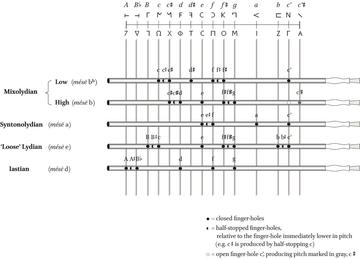
Diagram of further aulos harmoniai with ancient notation (Lynch, forthcoming)
Day 1 continued with a session on ‘Words, prosody and music in ancient Greek and Jewish tradition’. The Greek model was illustrated by Prof. Armand D’Angour (Oxford), who illustrated how the musical features of ancient Greek songs matched the musical nature of Greek prosody: their melodic profiles were based upon the pitch accents of the texts, whereas their rhythmical features derived from the quantitative nature of ancient metre (i.e. their alternations of long and short syllables). Armand also discussed the principles that informed his recent reconstruction of the Orestes Papyrus, which was performed at the Ashmolean Museum in 2017.
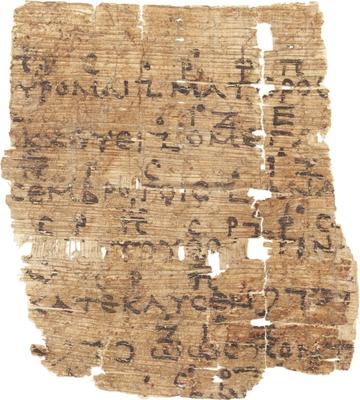
The Orestes Papyrus: Papyrus Vienna G 2315 — Euripides, Orestes 338-44 = 322-8
Dr Danny Crowther (Oxford) subsequently discussed the role of Masoretic cantillation marks (te'amim) in the Hebrew Bible, and the problems raised by recent attempts to reconstruct ancient practice on this basis – with special reference to William Wickes and Suzanne Haїk-Vantoura. Danny examined the theoretical premises that underpin these scholarly approaches, and contrasted them with the great variation of modern and contemporary performance practice: for more details, see Danny’s doctoral thesis.
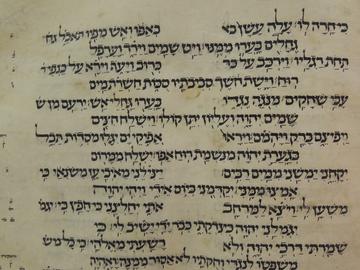
An example of Cantillation marks in the Hebrew Bible: Bod. Marshall Or. 3, Ashkenazi, C12th?
In the closing session of Day 1, we focused on the evidence offered by a Greek papyrus with notated music, which records the earliest Christian hymn that has survived to this day. This key document is now housed in the Oxford Oxyrhynchus Papyri Collection and was discussed by Prof. Charles Cosgrove (Garrett-Evangelical Seminary, US), a world-leading authority on this musical piece and author of the only existing monograph wholly devoted to it. Charles illustrated the main features of the ‘sound’ of ancient Christian song, starting from the scale and rhythmical modules employed in this piece. He also addressed the significance of the lyrics of this song, which opens with a traditional call for silence and culminates in a choral performance shared with universal ‘powers’ – angels that join in the musical performance of divine hymns of praise.

Ancient Christian Hymn: P. Oxy. XV 1786 (DAGM 59) – Papyrology Room, Oxford Sackler Library.
To round off the first day of our workshop, two musicians — Callum Armstrong and Barnaby Brown — presented archaeologically-informed replicas of different kinds of Graeco-Roman double-pipes (auloi) and flute (plagiaulos). Callum and Barnaby undertake experimental work to explore what new sounds might be produced from archaeological reconstruction of ancient Greek instruments; they also performed for us extracts of ancient scores and some variations upon ancient instrumental exercises written in the treatise Anonyma Bellermanniana.
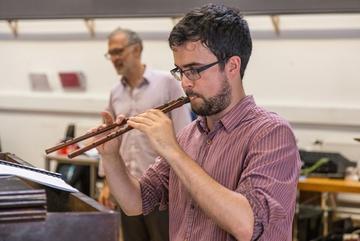
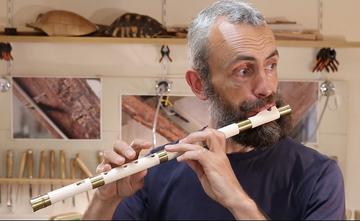
Callum Armstrong on the double-pipes (aulos); Barnaby Brown on the flute (plagiaulos)
***
The morning sessions of Day 2 focussed on the interplay between the Greek heritage and the development of new musical forms and performance styles in Late Antiquity and the Early Middle ages. This thorny topic was discussed from a variety of angles, both technical and more broadly cultural, by distinguished colleagues that joined us from other institutions.
Prof. Andreas Haug (Würzburg) explored the impact that Late Antique religious transformations had on the emergence of ritual of chant, and on the formation of Western music more broadly. Andreas addressed the transition from animal sacrifice to the idea of singing as a ‘bloodless sacrifice’ of praise, from a material to a spiritual idea of sacrifice, and its technical impact. Andreas focused especially upon discussions on value of the voice, of singing vs reading in spiritual contexts, and on the development a new visible medium to write down chant (cantilena) by means of discrete series of symbols called neumes—symbols that indicated complex musical tropes, as opposed to, e.g., the individual note signs employed in the ancient Greek musical fragments.
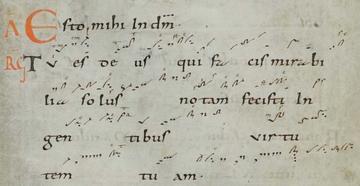
An example of early neumatic notation: Tu es Deus, Codex Sangallensis 359.
Prof. Charles Atkinson (Ohio/Würzburg, former president of the American Musicological Society) subsequently looked at the ways in which early mediaeval chants could modulate, comparing and contrasting two areas of Christendom: Byzantium and the West. Charles focussed on the similarity of their modulatory techniques, as well as on differences in the kinds of texts they set and the ways in which they were set to music. His paper incorporated new, unpublished findings from Western harmonic treatises as well as a detailed discussion of a Byzantine musical exercise (mathēma) now preserved in the National Library at Athens.
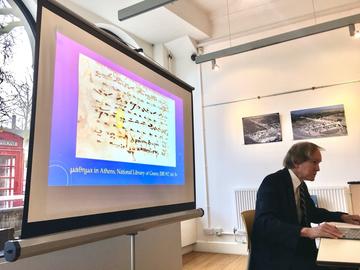
Charles Atkinson discussing the Athens mathēma (Athens National Library 917, fol 3v)
Dr Alexander Lingas (London) addressed the question of continuity/discontinuity between the singing of early Christians in the Eastern Mediterranean and the repertories of liturgical chant now commonly known as ‘Byzantine Music’, distinguishing issues of musical form and practice from those of textual content and theological interpretation. Drawing upon his experience as performer and Director of the ensemble Cappella Romana, Alexander gave us some practical demonstrations too — including extracts from Romanos the Melodist as well as other examples taken from Byzantine chant that illustrated variations in rhythmical delivery.
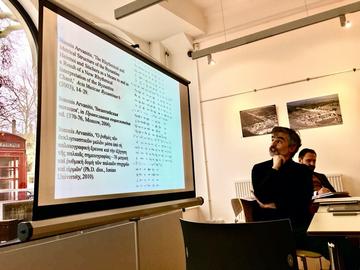
Alexander Lingas on rhythmical variations in Byzantine Chant
Prof. Emma Hornby (Bristol) explored themes developed by Iberian theologians such as Isidore of Seville and Ildefonsus of Toledo, as well as quotations/paraphrases from Augustine and Gregory the Great that were employed in prayers, showing how they correlate with the theological tradition displayed in the Old Hispanic common of the saints. In particular, Emma analysed conflicting and developing ideas of ‘martyrdom’ – especially their role as ‘witnesses’, model confessors, exegetes, and exceptional individuals who cared for the poor and engaged in intercession — and looked at how different chant styles contributed to devotional experience.
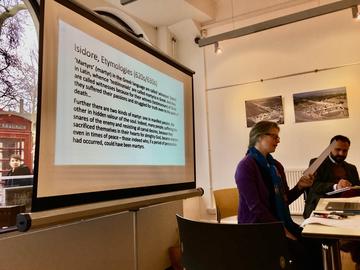
Emma Hornby on the Confessor Saints: a different concept of martyrdom
The final session of the Workshop took place in the afternoon of Day 2, and examined the role of musical practice in the early Church and Christian tradition. It featured a second paper by Prof. Charles Cosgrove (Garrett-Evangelical Seminary, US) that showcased some of his latest research into the role of shared singing in early Christian Social Meals. Charles discussed a wide array of evidence, starting from the definition of the Psalms as ‘hymns’ and ‘odes’ in Greek sources; he then focussed on passages discussing specific musical practices in the contexts of Christian social meals, ranging from Paul to Clement of Alexandria and the later apostolic tradition.
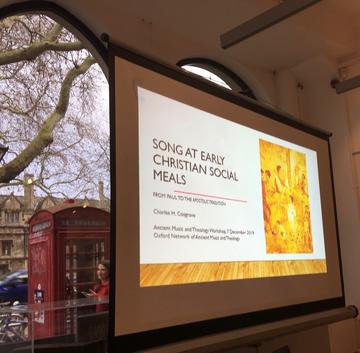
A snapshot of Charles Cosgrove’s presentation on Song at early Christian Social meals
This session was closed by Prof. Carol Harrison (Oxford), who addressed the role of music in early Western Christianity. Carol discussed the emphasis placed upon ‘sweetness’ (suavitas) as a distinctive trait of ancient Jewish and Christian song, and the beguiling effect of these songs – with special references to Ambrose and Augustine, the topic of her recent monograph. Carol also illustrated how the emotional power of music was harnessed to reach deeper spiritual levels and responses in liturgical contexts: spiritual songs, chants and hymns became true ‘incantations’, spiritual remedies that produced memorable and lasting transformations of the soul.
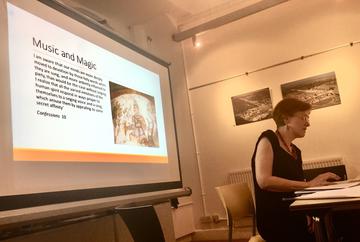
Carol Harrison on the emotional and spiritual effects of song in Augustine
Tosca A.C. Lynch
